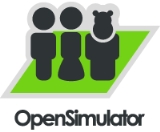
OpenSimulator
Encyclopedia
OpenSimulator is an open-source server platform for hosting virtual world
s. It is compatible with the client for Second Life
and can host alternative worlds with differing feature sets with multiple protocols.
OpenSimulator utilizes loadable modules for most of its functionality. These loadable modules can be independently developed to add functionality to the server. The OpenSimulator Project is hosting a collection of these loadable modules on OpenSimulator GForge
.
OpenSimulator currently uses the Second Life protocol for client to server communication, and is compliant with the Second Life viewer by Linden Lab
as well as a range of other virtual worlds viewers being developed by the open-source community. Interoperability with Second Life protocols has been a design goal since 2007.
OpenSim also uses an architecture known as "Hypergrid", which allows users to teleport between multiple OpenSim-based virtual worlds by providing a hyperlink
ed map which indexes public grids. This allows for public grids to retain teleportation links to each other without having to be on the same grid. There are several public grids available which usually require registration. Grids generally contribute to the project through testing and community participation. These budding multiverses normally contain user generated content and may be based around user contributed resources.
Virtual world
A virtual world is an online community that takes the form of a computer-based simulated environment through which users can interact with one another and use and create objects. The term has become largely synonymous with interactive 3D virtual environments, where the users take the form of...
s. It is compatible with the client for Second Life
Second Life
Second Life is an online virtual world developed by Linden Lab. It was launched on June 23, 2003. A number of free client programs, or Viewers, enable Second Life users, called Residents, to interact with each other through avatars...
and can host alternative worlds with differing feature sets with multiple protocols.
Features
OpenSimulator is written in C# and is designed to be easily expanded through the use of plugin modules. OpenSimulator can operate in one of two modes: standalone or grid mode. In standalone mode, a single process handles the entire simulation. In grid mode, various aspects of the simulation are separated among multiple processes, which can exist on different machines. Standalone mode is simpler to configure, but is limited to a smaller number of users. Grid mode has the potential to scale as the number of users grows.OpenSimulator utilizes loadable modules for most of its functionality. These loadable modules can be independently developed to add functionality to the server. The OpenSimulator Project is hosting a collection of these loadable modules on OpenSimulator GForge
GForge
GForge is a free software fork of the web-based project-management and collaboration software originally created for SourceForge, called Savane...
.
OpenSimulator currently uses the Second Life protocol for client to server communication, and is compliant with the Second Life viewer by Linden Lab
Linden Lab
Linden Research, Inc., d/b/a Linden Lab, is a privately held American Internet company that is best known as the creator of Second Life....
as well as a range of other virtual worlds viewers being developed by the open-source community. Interoperability with Second Life protocols has been a design goal since 2007.
OpenSim also uses an architecture known as "Hypergrid", which allows users to teleport between multiple OpenSim-based virtual worlds by providing a hyperlink
Hyperlink
In computing, a hyperlink is a reference to data that the reader can directly follow, or that is followed automatically. A hyperlink points to a whole document or to a specific element within a document. Hypertext is text with hyperlinks...
ed map which indexes public grids. This allows for public grids to retain teleportation links to each other without having to be on the same grid. There are several public grids available which usually require registration. Grids generally contribute to the project through testing and community participation. These budding multiverses normally contain user generated content and may be based around user contributed resources.
See also
- Open Wonderland – A Java-based open source 3D toolkit for creating collaborative virtual worlds.

